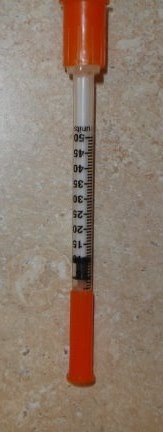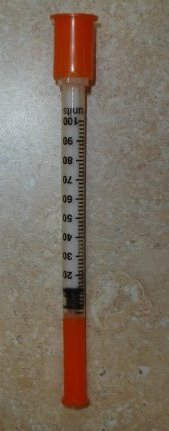
|
9539 Liberty Road, Frederick, MD 21701
Phone: 301-898-4009 ~ Fax: 240-668-3664
clientcenter@frederickcatvet.com
Gentle, complete veterinary care for the felines in your family
|

|
My Cat Has Diabetes What?
Hearing a diagnosis of diabetes is naturally upsetting, but it is a disease that can be managed quite well and in a fair number of cases brought into remission with diet and exercise alone. Dealing with syringes and having to give insulin shots can be intimidating and there is a need for exams and regular monitoring of blood glucose levels
We will take you through the process step-by-step and are here to answer all of your questions.
It is common in pets and is caused by the inability of the hormone insulin to properly balance blood sugar (glucose) levels in the body. In a diabetic, the pancreas stops producing enough insulin (type 1 diabetes) or the cat's body cells don't respond well to insulin (type 2 diabetes).
Both type 1 and 2 result in high blood sugar levels because the cat's body is unable to process the available glucose. (High blood sugar is referred to as 'Hyperglycemia' opposed to low blood sugar which is called 'Hypoglycemia' and can be deadly).
Just because a cat has been diagnosed as a diabetic doesn't mean that they will require insulin treatments. Diabetes can be managed by diet as well as by medication. Regular monitoring by your veterinarian is an essential step as well.
Clinical Signs of Diabetes
There are a combination of clinical signs that let us know we may be seeing a diabetic cat:
Weight Gain / Loss- in early stages, diabetics may gain weight as their appetite will increase and their internal insulin levels will rise and fall. Typically, in spite of having a good appetite, diabetics will eventually lose weight since their bodies are unable to process sugars into energy.
Excessive Urination- diabetics that develop hyperglycemia will begin passing the excess sugar (glucose) into their urine. Glucose acts as a diuretic and pulls extra water into the urine making it very dilute
Excessive Thirst- excessive urination is followed by excessive thirst to compensate for lost fluid.
Lethargy- Your cat's activity level may have dropped and you may notice that he doesn't play as much or climb the stairs as eagerly as before.
Treatment for the Diabetic Cat
Treatment generally involves three components:
Diet- canned food has much better protein and carbohydrates levels than dry food, and best control is achieved by avoiding dry food altogether. Even the very best dry foods have more carbohydrates than a cat needs (which should really be about 0-2% of their calories). Dry food is a baked product and it is difficult to make a commercially made product that does not have starch to keep the shape of the dry kibble.
Insulin Injections- Roughly half of diabetic cats require insulin injections long-term to manage diabetes. Lantus (glargine) insulin is the preferred choice currently for new diabetics and is usually given every 12 hours. Each cat responds differently to insulin, so the proper choice of insulin type, dose and frequency of administration will need to be individually determined.
Exercise - For overweight cats, getting to a healthy weight is essential. For all cats, good exercise daily helps build muscle mass and helps to normalize metabolism.
Determining Insulin Needs
Blood Glucose Spot Checks- This is a blood test done six hours after morning meal and insulin injection. This point represents the lowest point for the blood glucose level and the most critical time for us to monitor. It is much safer to cats to have a slightly elevated glucose than slightly low, as they can very rapidly get sick and extremely lethargic.
Giving Insulin Injections
Once we have established that your cat will benefit from daily injections, we will have a consultation with those in your family that will be responsible for giving your cat insulin. We will demonstrate the proper handling, care and use of the insulin as well as the syringes used. A few tips:
Insulin must be refrigerated to ensure long life(preferably not stored in the fridge door). Glargine insulin is OK if stored at room temperature for 30 days, but when refrigerated, it can be used for at least 6 months if it does become contaminated.
Some types of insulin need to be gently rolled to mix well, but since glargine insulin is a solution it never needs to be shaken or rolled
Syringes are single-use only and sterile.

The 50 unit syringe (shown above) and some 100 unit syringes count by ones. These are more accurate when measuring your cat's prescribed dose of insulin.
|

The 100 unit syringe (shown above) counts by two, making odd unit doses harder to measure accurately.
|
Giving the injection in varied body sites reduces scar tissue (don't give Fluffy the injection in the same spot everyday)
Staying on schedule (typically once every 12 hours) with insulin is ideal for good control of diabetes. While doses may be missed occasionally, that should be kept to an absolute minimum.
If you are not sure if the injection went properly, do not repeat it, and this introduces risk of giving too much insulin. Too much insulin causes blood sugar to drop too low, and this often necessitates an emergency room visit
The signs of blood glucose dropping too low include hesitation to eat or finish a meal as usual, profound lethargy, glassy-eyed appearance, and if very low a seizure or state of unconsciousness. If a meal is skipped, then skip the insulin and contact us right away.
Diabetes is a treatable disorder and should not be considered a death sentence. Many cat owners are able to monitor and control their cat's condition for years, and the cat can have a normal, healthy life. Diabetes is a complex condition, but there are numerous venues that can provide you with information; your veterinary staff, support groups, websites, etc. If you don't understand something always ask. Diabetic cats may live for many years with an attentive owner that is willing to put forth the effort required to maintain and monitor this disease.
-Mike Karg, DVM
|



